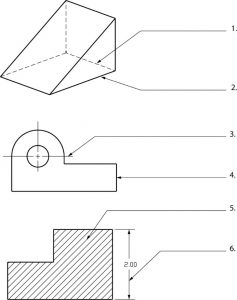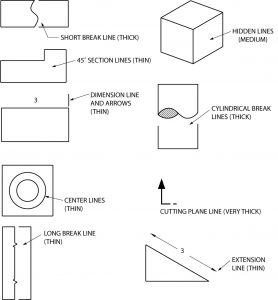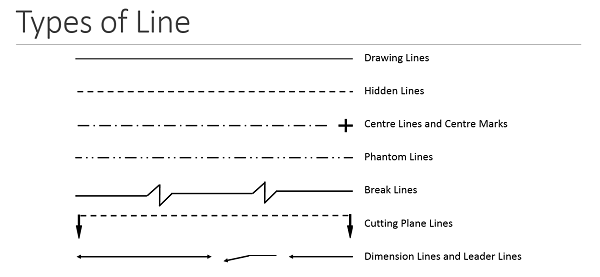Imagine sketching the front view of a house. The shape and size of the various parts of the machine and its structure must be recorded on flat plates in a systematic way for.

Engineering Design And Cad A B Line Types Flashcards Practice Test Quizlet
Object line Figure 3 Object lines Hidden lines.

. These lines are drawn to represent hidden or invisible edges of the objects. Answer 1 of 8. It is an axonometric projection in which the three coordinate axes appear equally foreshortened and the angle between any two of.
A visible line or object line is a thick continuous line used to outline the visible edges or contours of an object. CONSTRUCTION LINE Very light and thin line use to construct layout work. Visible lines are the edges or outlines of an object.
Object line in engineering drawing What are the symbols used in engineering drawing. A common use is to specify the geometry necessary for the construction of a component and is called a detail drawingUsually a number of drawings are necessary to completely specify even a simple component. Basic Types of Lines Used in Engineering Drawings By Kelly Curran Glenn Sokolowski.
A line on a drawing always indicates either an intersection of two surfaces as in the projection of a prism or a contour as in the projection of a cylinder fig. All other lines contrast with the visible lines by having either a thinner weight. In this highly interactive object learners associate basic line types and terms with engineering drawing geometry.
Usually terminates with arrowheads or tick markings. Engineers compare with the task of communicating machine design development and structures to manufacturers and manufacturers. Isometric drawings provide a systematic way to draw 3-dimensional objects.
Construction lines and guide lines are very light easily erased lines used to block in the main layout. A quiz completes the activity. These thick solid lines show the visible edges corners and surfaces of a part.
An engineering drawing is a type of technical drawing that is used to convey information about an object. Thin hidden lines are used as intermittent line types. The first dimension line should be approximately 12 mm 06 in from the object.
1o a visible edge being represented by a full line and an invisible one by a dotted line ie a line made up of short dashes. In oblique projection the object is aligned such that one face front face is parallel to the projection plane. In general application thick lines are 06 mm024.
DIMENSION LINE Thin and dark lines use to show the size span of an object with a numeric value. OBJECT OR VISIBLE LINES Thick dark line use to show outline of object visible edges and surfaces. Object lines Object lines Figure 3 are the most common lines used in drawings.
Extension lines begin 15 mm from the object and extend 3 mm from the last dimension line. They are drawn as solid lines with a thickheavy weight. In other words The art of representing a real or imaginary object precisely using some graphics symbols letters and numbers with the help of engineering drawing instruments is called engineering drawing.
Line parallel to one of the legs of the isometric axis is an isometric line. Hidden lines show edges or features that are not visible from the particular view. Although THICK lines of Type-E are recommended for representing the hidden edges THIN lines of Type-F are preferred.
These lines are used for the main lengths of the object view. Put simply these lines are for drawing the objects. Isometric projection is a method for visually representing three-dimensional objects in two dimensions in technical and engineering drawings.
Linetypes And Weight Standards In Technical Drawing. Object lines stand out on the drawing and clearly define the outline and features of the object. This line is used to represent the center line for circles and arcs.
A leader is a thin line used to connect a dimension with a particular area figure 24. Object lines are used in hand drawing and CAD to define the edges of the view being drawn. Detail Views A detail view is a separate large-scale drawing view of a small section of another view.
Thick and visible line. Hidden Line A hidden line also known as a hidden object line is a medium weight line made of short dashes about 18 long with 116gaps to show edges surfaces and corners which cannot be seen. In such projection the projectors are not perpendicular to the plane of projection rather inclined to the plane of projection at 30 45.
Graphic language use lines to represent the surfaces edges and contours of objects. Many other line types exist and are used to communicate things like interior detail but object lines are the darkest lines on the pagescreen. Centre lines Lines of Symmetry Trajectories and Pitch Circles.
Composition of Graphic Language The language is known as drawing or drafting. This line is used to represent the location of a cutting plane. On a paper is called engineering drawing.
One can not read a drawing by looking at one view. The most common is a continuous line also known as a drawing line. This represents the physical boundaries of an object.
The art of representing engineering objects such as buildings roads machines circuits etc. The different options make it possible to show both visible and hidden edges of a part centre lines etc. What are normal isometric lines.
Isometric drawings include three axes. This line is used to show hidden edges of the main object. An extension line extends a line on the object to the dimension line.
The holes are shown on the front view by hidden lines in this example. Hidden Lines Thin type lines consist of thin short dashes closely and evenly spaced. Engineering Working Drawings Basics Page 8 of 22 parallel to the object surface.
Line weight is the thickness of the line. This line is located in front of cutting planes outlines of adjacent parts censorial Lines and to state center of gravity. A drawing can be done using freehand instruments or computer methods.
One vertical axis and two horizontal axes that are drawn at 30 degree angles from their true position. Therefore any surface that is not in line with the three major axis needs its own projection plane to show the features correctly. Not every line on an engineering drawing is equal.
Thin lines are nearly 03 mm012 in most technical drawings.

The Language Of Lines Basic Blueprint Reading

Line Types Engineering Drawing Wikipedia Line Art Lesson Types Of Lines Different Types Of Lines

Engineering Drawing Notes B Drawings Engineering Types Of Drawing

What Are Lines Types Of Lines In Engineering Drawing Youtube

The Language Of Lines Basic Blueprint Reading


0 comments
Post a Comment